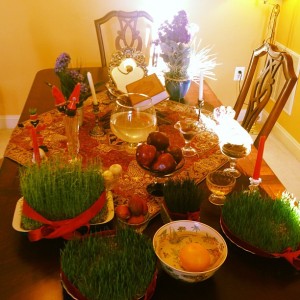Elmira Jafari is a guest producer with CCTV America in Washington, D.C. She occasionally blogs about Iran and Iranian culture.
Leap over the fire! Leap over the fire!” my dad used to scream to all the children who were standing patiently in line for their turn. Some were scared. Some were excited. Sometimes you had the adults, who would try to show-off by jumping highest over the fire.
They’d been waiting all year for this sunset to begin the Chahar Shanbeh Suri (Festival of Light) celebration. This would happen on the last Tuesday night of the Persian calendar every year, as it had for centuries to keep the Persian New Year celebration alive.
Adults ate dried nuts and Ash Reshteh (a traditional Iranian noodle soup) as they huddled by the flames of fire pits singing, “my yellowness belongs to you, your redness belongs to me,” a metaphor referring to sweeping away sickness and evil from the past year and bringing health and prosperity to start the new one.
Photos Full Screen: Celebrating the Persian New Year
[flagallery gid=99]
Just like other children in Iran, I celebrated the fun of fire and yummy food as a herald of spring. But the importance of this unique celebration took on a deeper meaning as I got older, especially when I began to celebrate it outside of Iran.
As many Persians would argue, this is a time to surround yourself with your culture, to speak the language, enjoy the traditional foods, and be around your people.
Chahar Shanbeh Suri is the pre-celebration of the Persian New Year, called Norooz, meaning “a new day.” It has been celebrated for around 3,000 years and is still observed in Iran and in other nations. In fact, it has become so widespread that in 2010, the U.N. General Assembly recognized the International Day of Norooz. Canadian parliament also added Norooz to its national calendar in 2009.
So, what does this holiday really look like? Here’s the breakdown:
Spring
The Norooz celebration coincides with the spring equinox, which is generally on or around March 21. This is the time when sunlight is evenly divided between the northern and southern hemispheres. Iranians start the celebration of Norooz at the exact point spring arrives. So, this could be midnight, 3:00 p.m. or 5:00 a.m. This exact moment is important because Persians believe whatever you’re doing at that point in time will determine your luck in the following year.
Now, let’s talk about the fun stuff.
Haft-seen
Growing up in an Iranian household, you become a pro in setting up your haft-seen table. It’s such a huge part of the culture that parents start teaching their children it right along with their A-B-C’s. Haft-seen means “seven S’s” and refers to a traditional table setting that includes seven items that all start with the letter S. Each represents an important symbol of life and a message of spring.
- Sabzeh (wheat sprout) is a symbol of rebirth.
- Sib (apple) represents beauty and health.
- Sir (garlic) is a symbol of medicine.
- Serke (vinegar) represents age and patience.
- Somagh (an ancient spice) is the color of sunrise.
- Senjed (dried fruit) and samano (an ancient pudding) bring love and affluence to the table.
Persians spend the last couple weeks of the year decorating their haft-seens with much care, attention, and love. The details have to be simply perfect otherwise it won’t be complete. In order to make the setting more beautiful and poetic, they add a mirror, hyacinth flowers, a bowl of goldfish, and a book of poetry by Hafiz, a Sufi poet. It’s like having a glimpse of spring in your house.
Cuisine
And now the best part, the food! Sabzi polo Mahi is traditionally served on the night before the New Year. It’s a dish of rice cooked with fresh herbs and served with smoked and fried fresh fish. Koukou Sabzi, a vegetable patty, is a mixture of fresh herbs mixed with eggs, turmeric, salt and pepper cooked to perfection. Iranians take pride in preparing this dish every year. This is the time for all family members to come together, eat, laugh and enjoy a piece of delicious culture.
No. 13
The Norooz celebration lasts 13 days. The 13th day is called Sizdah Bedar, which means to get rid of the number 13. Iranians believe that this day will bring bad luck and in order to avoid it, they go out to picnic, eat Ash Reshteh and skewered kebobs. They take the Sabzeh from their haft-seen and throw it into running water, a gesture that shows life goes on with its good and bad.
The Persian New Year is a symbol of love, peace, and new beginnings — a message that every Iranian tries to remember and carry out throughout the year.
So from one Persian to all, Norooz -e-tan moubarak! (Happy New Year!)

 CGTN America
CGTN America
 Haft-seen set up
Haft-seen set up
